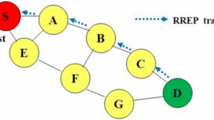Abstract
The study of energy constrained routing protocols in mobile Ad Hoc Networks (MANET) is attracting more attention recently. The typical MANET routing protocols of IETF are shortest routing protocols, that is, the least hops but do not consider the energy aware problem. Because the ad hoc networks is an energy constrained system with the portable devices, it is a very important metric to evaluate the routing protocols whether which have a longer network lifetime or not. Based on the mobile node energy level and using the different forward tactics, this paper presents an energy level based routing protocol-ELBRP. The routing protocol not only makes the system energy consumption low but also prolongs the system lifetime and improves the delay characteristic. In this paper, the proof of correctness and complexity analysis of ELBRP are given. This paper compares the performance of existing protocols AODV, RDRP and proposed ELBRP via simulation. The simulation result shows that ELBRP has a better delay performance, a lower energy consumption and longer network lifetime than the other two and provides an available approach to as hoc networks routing.












Similar content being viewed by others
References
Perkins, C. E., & Bhagwat, P. (August 1994). Highly dynamic destination-sequenced distance-vector routing (DSDV) for mobile computers. In Proceeding of the SIGCOMM’94 Conference on Communications Architectures, Protocols and Applications, pp. 234–244. A revised version of the paper is available from.
Perkins, C. (July 2003). Ad hoc On-Demand Distance Vector (AODV) Routing, RFC3561[S].
Johnson, D. B., Maltz, D. A., & Hu, Y.-C. (July 2004). The dynamic source routing protocol for mobile ad hoc networks. Interet-Draft, draft-ietf-manet-dsr-10.txt.
Park, V. D., & Corson, M. S. (November 1997). Temporally-ordered routing algorithm (TORA) version 1: Functional specification. Internet-Dfaft, draft-ietf-manet-tora-spec-00, txt.
Rodoplu, V., & MENG, T. H. (1997). Minimum energy mobile wireless networks. IEEE Journal on Selected Areas in Communication, 17(8), 1333–1344.
Malek, A.-G., Li, C., Li, L., & Bo, W. (2010). New energy model: Prolonging the lifetime of ad-hoc on-demand distance vector rounting protocols (AODV). In 2nd International conference on future computer and communication, pp 2426–2429.
Bergamo, P., Giovanardi, A., & Travasonia., et al. (January 2004). Distributed power control for energy efficient routing in ad hoc networks [EB/OL]. Wireless Networks, 10(1), 29–42. http://citeseer.nj.nec.com/552450.html.
Gomez, J., Campbell, A. T., & Naghshineh, M., et al. (November 2001). Conserving transmission power in wireless ad hoc networks. In Proceedings of IEEE conference on network protocols (ICNP.01).
Rahman, A., & Gburzynski, P. (2005). On constructing minimum-energy path-preserving graphs for ad-hoc wireless networks. ICC2005: IEEE International Conference on Communications, 1–5, 3083–3087.
Sihai, Z., Li, L., & Lijie, Y. (2012). A preemptive multicast routing protocol in MANET. International Journal of Advancements in Computing Technology, 4(1), 256–263.
Sihai, Z., Li, L., & Lijie, Y. (2012). A QoS routing protocol for mobile Ad Hoc networks based on multipath. Journal of Networks, 7(4), 691–698.
Yin, S. Y., & Lin, X. K. (2005). Multipath minimum energy routing in ad hoc network. ICC 2005:IEEE International Conference on Communications, 1–5, 3182–3186.
Liang, W. F. (2005). Minimizing energy and maximizing network lifetime multicasting in wireless ad hoc networks. ICC 2005:IEEE International Conference on Communications, 1—-5, 3375–3379.
Zhao, W., Stankovic, J., & Ramamritham, K. (September 1990). A window protocol for trasmission of time constrained messages. IEEE Transactions on Computers, 39(9).
Zhao, W., & Ramamritham, K. (August 1987). Virtual time CSMA protocols for hard real-time communications. IEEE Transactions on Software Engineering, SE-13(8).
Prakash, R. (August 20, 1999). Unidirectional links prove costly in wireless ad-hoc networks. In Proceedings of the discrete algorithms and methods for mobile computing and communications-dial M’99, (pp. 15–22). Seattle, WA.
Wang, L., & Li, L. (2012). A combined algorithm routing protocol based on energy for wireless sensor network. International Conference on Computer Science and Electronics Engineering, 2012/3/23-2012/3/25, pp. 224–228.
Li, L., & Li, C. (2004). A QoS-guaranteed multicast routing protocol. Computer Communications, Elsveier, 27(1), 59–69.
Wang, X., & Li, L. (2012). Research of an adaptive aggregation routing algorithm in wireless sensor networks. Journal of Networks, 7(7), 1071–1077.
Li, L., & Li, C. (2004). A QoS multicast routing protocol for dynamic group topology. Information Science, 169(1/2), 113–130.
Li, L., & Li, C. (2003). A distributed QoS-aware multicast routing protocol. Acta Informatica, Spring-Verlag Heidelberg, 40(3), 211–233.
Rappaport, T. S. (1995). Wireless Communications, Principles and Practice. Upper Saddle River NJ: Prentice Hall.
IEEE Computer Society LAN MAN Standards Committee, Wireless LAN Medium Access Protocol (MAC) and Physical Layer (PHY) Specification, IEEE Std 802.11-1997.
Kasten, O. Energy consumption. ETH-Zurich, Swiss Federal Institute of Technology. http://www.inf.ethz.ch/kasten/Research/bathtub/energy-consumption.html.2001.
Luo, L., & Li, L. An ant colony system based routing algorithm for wireless sensor network. In 2012 International conference on computer science and electronics engineering, 2012/3/23-2012/3/25, pp. 376–379.
Acknowledgments
The work was supported by the National Natural Science Foundation (NSF) under grants (Nos. 61472294, 61171075), Key Natural Science Foundation of Hubei Province (No. 2014CFA050), Applied Basic Research Project of WuHan, National Key Basic Research Program of China (973 Program) under Grant No. 2011CB302601, Program for the High-end Talents of Hubei Province, Open Fund of the State Key Laboratory of Software Development Environment (SKLSDE). Any opinions, findings, and conclusions are those of the authors and do not necessarily reflect the views of the above agencies.
Author information
Authors and Affiliations
Corresponding author
Rights and permissions
About this article
Cite this article
Li, L., Li, C. & Yuan, P. An Energy Level Based Routing Protocol in Ad Hoc Networks. Wireless Pers Commun 81, 981–996 (2015). https://doi.org/10.1007/s11277-014-2166-4
Published:
Issue Date:
DOI: https://doi.org/10.1007/s11277-014-2166-4




